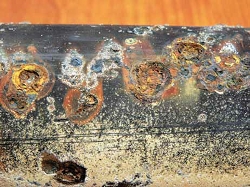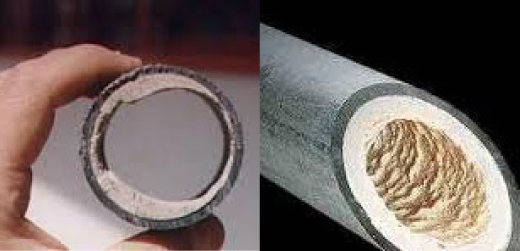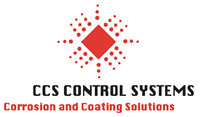When thinking about the safe operation of boilers (and don't we all?), several systems can readily be named; flame control, fuel/air ratio; steam pressure control, levels in the vessel, etc. What about the water? It seems so passive, as long as there is enough for level control, what's the big deal? Well, it turns out, that as the steam produced by a boiler is used in the process, the condensate from that steam is returned to the boiler as feedwater. However, since 100% of the condensate is not returned, whatever solids had been in that water before it evaporated to form steam are left in the remaining water. Fresh feedwater is added to maintain levels, but even fresh water contains some dissolved solids. So over time, the water in the boiler system gets saturated with all sorts of dissolved minerals.
Boiler blowdown is the process of removing the heavily saturated water from the system. This means more make-up feed water is needed than to account for just process losses. This fresh feedwater has less impurities than the system water. Sampling/testing the system water, will let the operator know how much dirty water needs to be removed. An equal amount of fresh is added to maintain proper system water chemistry. Boiler water chemistry is something that needs to be monitored to ensure the safe operation and long operating life of a boiler.
A corroded boiler tube

There are two main types of boiler blowdown, and they are typically both employed in modern systems. The first type is bottom blowdown. This is done periodically (once a shift, once a day, etc.) and usually from the mud drum of the boiler (guess what's in there?). This is where solids that have come out of solution and settled accumulate. Bottom blowdown can be automated or done manually. The second type is called surface blowdown. In larger systems this is done continually and is automated, in smaller systems, it may still be a manual procedure. In either case of surface blowdown, the system water is removed from the steam drum, which contains the most dissolved solids. The continuous stream that leaves the drum typically passes through one of the water level controls before exiting via a vent line.
This performs the double duty of removing impurity-laden water and keeping the level control legs free of scale/buildup. Several common failure modes in steam systems involve poor water level control. If the water level gets too low, the tubes can be exposed to flame, this is known as dry firing and it weakens the metal of the tubes. If the water level gets too high, slugs of water can be entrained in the steam and enter the steam pipes which will cause erosion and corrosion in that system as well.
For all blowdowns, the amount of water removed is adjusted based on results from water chemistry tests. As shown in the figures, if proper boiler water chemistry is not maintained, either corrosive compounds or solid material can build up to dangerous levels in the system. Pipes can either become corroded such that they fail to withstand the pressure differential from either side, or they can become clogged from solids adhering to the inner wall. Reminds you of either an aneurysm or a clogged artery in the human body, doesn't it? I would say that steam is the lifeblood of many chemical plants, but that's probably taking the analogy a little over the top...
 Scale on the inside of a tube
Scale on the inside of a tube
In conclusion, if you have a failure in a boiler, be sure to investigate all the control systems mentioned at the beginning of this blog, but also include boiler blowdown and boiler water chemistry control history and practices.
Jennifer Morningstar, BSChE, PE, CFEI has 19 years of industrial experience. Her areas of emphasis include chemical release & exposure, OSHA process safety management, industrial accident investigation, fires & explosions, and scope of damage/cost to repair analyses. She is an OSHA-trained Process Hazard Analysis study leader and completed Root Cause Failure Analysis training to become an Incident Investigator. She has experience as an energy management consultant in a variety of industries including mineral extraction, pulp & paper, animal harvesting & packaging (including rendering) and grain milling. Jennifer holds a Bachelor of Science Degree in Chemical Engineering from Virginia Polytechnic Institute and State University as well as a Masters of Business Administration from the University of South Carolina.
©Copyright - All Rights Reserved
DO NOT REPRODUCE WITHOUT WRITTEN PERMISSION BY AUTHOR.












